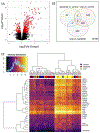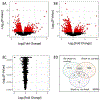Gene Expression Profiles in Children With Suspected Sepsis
- PMID: 31983492
- PMCID: PMC7261647
- DOI: 10.1016/j.annemergmed.2019.09.020
Gene Expression Profiles in Children With Suspected Sepsis
Abstract
Study objective: Sepsis recognition is a clinical challenge in children. We aim to determine whether peripheral blood gene expression profiles are associated with pathogen type and sepsis severity in children with suspected sepsis.
Methods: This was a prospective pilot observational study in a tertiary pediatric emergency department with a convenience sample of children enrolled. Participants were older than 56 days and younger than 18 years, had suspected sepsis, and had not received broad-spectrum antibiotics in the previous 4 hours. Primary outcome was source pathogen, defined as confirmed bacterial source from sterile body fluid or confirmed viral source. Secondary outcome was sepsis severity, defined as maximum therapy required for shock reversal in the first 3 hospital days. We drew peripheral blood for ribonucleic acid isolation at the sepsis protocol activation, obtained gene expression measures with the GeneChip Human Gene 2.0 ST Array, and conducted differential expression analysis.
Results: We collected ribonucleic acid samples from a convenience sample of 122 children with suspected sepsis and 12 healthy controls. We compared the 66 children (54%) with confirmed bacterial or viral infection and found 558 differentially expressed genes, many related to interferon signaling or viral immunity. We did not find statistically significant gene expression differences in patients according to sepsis severity.
Conclusion: The study demonstrates feasibility of evaluating gene expression profiling data in children evaluated for sepsis in the pediatric emergency department setting. Our results suggest that gene expression profiling may facilitate identification of source pathogen in children with suspected sepsis, which could ultimately lead to improved tailoring of sepsis treatment and antimicrobial stewardship.
Copyright © 2019 American College of Emergency Physicians. Published by Elsevier Inc. All rights reserved.
Conflict of interest statement
Conflict of Interest:
The authors have no conflicts of interest to disclose.
Figures



References
Publication types
MeSH terms
Grants and funding
LinkOut - more resources
Full Text Sources
Medical
Molecular Biology Databases

